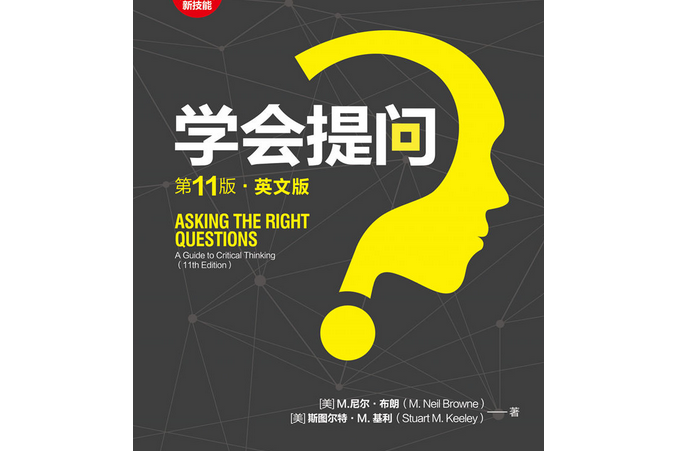基本介紹
- 中文名:學會提問(第11版)·英文版
- 作者:[美]M.尼爾·布朗(M. Neil Browne)、[美]斯圖爾特·M.基利(Stuart M. Keeley)
- 出版社:清華大學出版社
- 出版時間:2020年
- 定價:69 元
- ISBN:9787302533030
內容簡介,目錄,
內容簡介
本書具有簡明扼要、清楚易懂以及篇幅短小的特色。這本小書出色地完成了它的既定目標——傳授批判性思考和提問的技能。40多年向學生傳授批判性思維技能的經驗也讓我們確信,儘管學生們能力有差異、術業有專攻,只要我們用簡單易懂的方法向他們傳授批判性思維的技能,他們很快就能成功地將其套用於各種實踐。在學以致用的過程中,他們的信心逐步增強,在重大社會問題和個人問題方面,他們做出理性抉擇的能力也與日俱增,哪怕面對從前極少經歷過的重大問題,他們也一樣可以應對自如。
目錄
1
The Benefit and Manner of Asking the
Right Questions 1
The Noisy, Confused World We Live in 1
Experts Cannot Rescue Us, Despite What They
Say 4
The Necessity of Relying on Our Mind 5
Critical Thinking to the Rescue 6
The Sponge and Panning for Gold: Alternative
Thinking Styles 8
Weak-Sense and Strong-Sense Critical Thinking 10
The Importance of Practice 12
Critical Thinking and Other People 12
Values and Other People 12
Primary Values of a Critical Thinker 14
Keeping the Conversation Going 16
Creating a Friendly Environment for
Communication 19
CHAPTER
2
Speed Bumps Interfering with Your Critical
Thinking 20
The Discomfort of Asking the Right Questions 21
Thinking Too Quickly 21
Stereotypes 22
Mental Habits That Betray Us 23
Halo Effect 24
Belief Perseverance 24
Availability Heuristic 26
Answering the Wrong Question 27
Egocentrism 28
Wishful Thinking: Perhaps the Biggest Single Speed
Bump on the Road to Critical Thinking 29
CHAPTER 3 What Are the Issue and the Conclusion? 33
Kinds of Issues 34
Searching for the Issue 36
Searching for the Author’s or Speaker’s
Conclusion 37
Using This Critical Question 39
Clues to Discovery: How to Find the Conclusion 39
Critical Thinking and Your Own Writing and
Speaking 40
Narrowing Your Issue Prior to Writing 41
Cluing Your Reader into Your Conclusion 42
Practice Exercises 42
Sample Responses 44
CHAPTER 4 What Are the Reasons? 47
Initiating the Questioning Process 50
Words That Identify Reasons 52
Kinds of Reasons 52
Keeping the Reasons and Conclusions Straight 53
Using This Critical Question 54
Reasons First, Then Conclusions 54
Critical Thinking and Your Own Writing and
Speaking 55
Exploring Possible Reasons before Reaching
a
Conclusion 55
Identify Major Publications That Cover Your
Issue 56
Helping Your Readers Identify Your Reasons 57
Practice Exercises 57
Sample Responses 59
What Words or Phrases Are
Ambiguous? 62
The Confusing Flexibility of Words 63
Locating Key Terms and Phrases 64
Checking for Ambiguity 67
Using This Critical Question 67
Determining Ambiguity 68
Context and Ambiguity 70
Using This Critical Question 72
Ambiguity, Definitions, and the Dictionary 72
Ambiguity and Loaded Language 75
Limits of Your Responsibility to Clarify Ambiguity 76
Ambiguity and Your Own Writing and Speaking 77
CHAPTER
5
Keeping Your Eye Out for Ambiguity 77
Practice Exercises 79
Sample Responses 80
CHAPTER
6
What Are the Value and Descriptive
Assumptions? 84
General Guide for Identifying Assumptions 87
Value Conflicts and Assumptions 88
From Values to Value Assumptions 89
Typical Value Conflicts 91
The Communicator’s Background as a Clue to Value
Assumptions 92
Consequences as Clues to Value Assumptions 92
More Hints for Finding Value Assumptions 94
The Value of Knowing the Value Priorities of
Others 95
Using This Critical Question 96
Values and Relativism 96
Identifying and Evaluating Descriptive
Assumptions 97
Illustrating Descriptive Assumptions 97
Common Descriptive Assumptions 100
Clues for Locating Assumptions 101
Avoiding Analysis of Trivial Assumptions 103
Assumptions and Your Own Writing and
Speaking 104
Practice Exercises 106
Sample Responses 108
CHAPTER
7
CHAPTER
8
Are There Any Fallacies in the
Reasoning? 110
A Questioning Approach to Finding Reasoning
Fallacies 112
Evaluating Assumptions as a Starting Point 114
Discovering Other Common Reasoning
Fallacies 116
Looking for Diversions 123
Sleight of Hand: Begging the Question 126
Using This Critical Question 127
Summary of Reasoning Errors 127
Expanding Your Knowledge of Fallacies 128
Practice Exercises 128
Sample Responses 130
How Good Is the Evidence: Intuition, Personal
Experience, Case Examples, Testimonials,
and Appeals to Authority? 133
The Need for Evidence 134
Locating Factual Claims 136
Sources of Evidence 137
Intuition as Evidence 139
Personal Experience as Evidence 140
Case Examples as Evidence 141
Testimonials as Evidence 143
Appeals to Authority as Evidence 145
Using This Critical Question 149
Your Academic Writing and Evidence 149
Practice Exercises 150
Sample Responses 152
CHAPTER
9
How Good Is the Evidence: Personal
Observation, Research Studies, and
Analogies? 153
Personal Observation as Evidence 153
Research Studies as Evidence 154
General Problems with Research Findings 156
Generalizing from the Research Sample 162
Generalizing from the Research Measures 164
Biased Surveys and Questionnaires 166
Analogies as Evidence 169
Identifying and Comprehending Analogies 170
Evaluating Analogies 171
When You Can Most Trust Expert Opinion 174
Research and the Internet 176
Practice Exercises 178
Sample Responses 179
CHAPTER 10
Are There Rival Causes? 181
When to Look for Rival Causes 182
The Pervasiveness of Rival Causes 183
Detecting Rival Causes 185
The Cause or a Cause 185
Multiple Perspectives as a Guide to Rival
Causes 187
Rival Causes for Differences Between Groups 188
Confusing Causation with Association 190
Confusing “After This” with “Because of This” 192
Explaining Individual Events or Acts 193
Evaluating Rival Causes 194
Rival Causes and Your Own Communication 195
Exploring Potential Causes 196
Practice Exercises 197
Sample Responses 199
CHAPTER 11 Are the Statistics Deceptive? 201
Unknowable and Biased Statistics 203
Confusing Averages 204
Concluding One Thing, Proving Another 207
Deceiving by Omitting Information 208
Using Statistics in Your Writing 210
Practice Exercises 211
Sample Responses 212
CHAPTER 12
What Significant Information Is Omitted?
215
The Benefits of Detecting Omitted Information 216
The Certainty of Incomplete Reasoning 217
Questions That Identify Omitted Information 219
But We Need to Know the Numbers 220
The Importance of the Negative View 223
Omitted Information That Remains Missing 225
Using This Critical Question 225
Practice Exercises 225
Sample Responses 227
CHAPTER 13
What Reasonable Conclusions Are
Possible? 229
Dichotomous Thinking: Impediment to Considering
Multiple Conclusions 230
Two Sides or Many? 232
Productivity of If-Clauses 233
The Liberating Effect of Recognizing Alternative
Conclusions 234
Summary 235
Practice Exercises 236
Sample Responses 237
Final Word 238
Index 240

